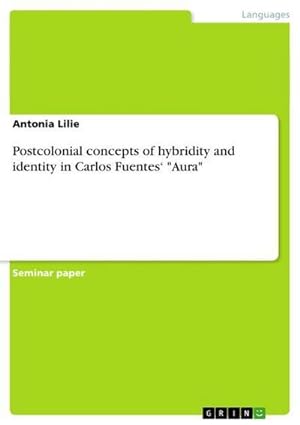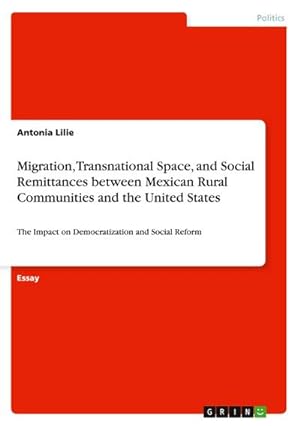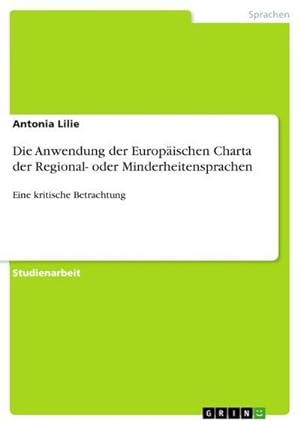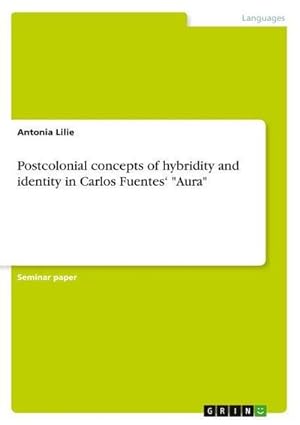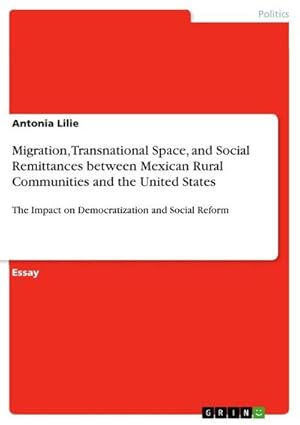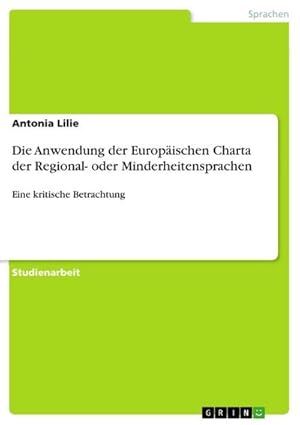Antonia Lilie (6 results)
Product Type
- All Product Types
- Books (6)
- Magazines & Periodicals
- Comics
- Sheet Music
- Art, Prints & Posters
- Photographs
- Maps
-
Manuscripts &
Paper Collectibles
Condition
- All Conditions
- New
- Used
Binding
- All Bindings
- Hardcover
- Softcover
Collectible Attributes
- First Edition
- Signed
- Dust Jacket
- Seller-Supplied Images
- Not Printed On Demand (3)
Seller Location
Seller Rating
-
Postcolonial concepts of hybridity and identity in Carlos Fuentes¿ "Aura"
Published by GRIN Verlag Feb 2012, 2012
ISBN 10: 3656111456ISBN 13: 9783656111450
Seller: BuchWeltWeit Ludwig Meier e.K., Bergisch Gladbach, Germany
Book Print on Demand
Taschenbuch. Condition: Neu. This item is printed on demand - it takes 3-4 days longer - Neuware -Seminar paper from the year 2011 in the subject Romance Languages - Latin American Studies, grade: 1,3, University of Toronto, language: English, abstract: In her essay 'Postcolonialism and Latin American literature: the case of Carlos Fuentes' Nadia Lie describes two different currents of Postcolonialism: the first one is the literature that grew out of colonial experience in Latin America and is considered an answer to the over present literature of the oppressing European literary traditions. The second one is characterized by a set of theoretical concerns and reading strategies. Rather than merely 'writing back', a term introduced by Bill Ashcroft, Gareth Griffiths and Helen Tiffin, this approach suggests that cultural differences are constructed by replacing the strong binary opposition 'us' versus 'the other' with concepts of hybridity, in-betweenness and border thinking (see Lie 2005: 139-140). The early work of Mexican author Carlos Fuentes (\*1928) can be seen in an intermediate position between these two concepts. Even though the theme of otherness and opposition is very present in his work, as can be seen in La frontera de cristal (1995) and his early novel Aura (1962), his writing is full of intertextual references that show his appreciation for both European and Latin American literary tradition. As part of the 'Boom' movement in Latin American literature he also uses supernatural and gothic elements that sometimes make it hard or even impossible to distinguish between reality and illusion:According to this aesthetic, unreal things are treated as if realistic and mundane, and mundane things as if unreal. Plots, while often based on real experiences, incorporate strange, fantastic, and legendary elements, mythical peoples, speculative settings, and characters who, while plausible, could also be unreal, and combine the true, the imaginary, and the nonexistent in such a way that they are difficult to separate. (Pope 1996: 229)Fuentes' novel Aura is an early example of this tradition. The purpose of this essay will be a postcolonial approach to the novel, showing Fuentes' position in the discourse of postcolonial identities and literatures. The argument will be based on notions of time, space and intertextual references that can be found in Aura. 16 pp. Englisch.
-
Migration, Transnational Space, and Social Remittances between Mexican Rural Communities and the United States
Published by GRIN Verlag Mai 2012, 2012
ISBN 10: 365619064XISBN 13: 9783656190646
Seller: BuchWeltWeit Ludwig Meier e.K., Bergisch Gladbach, Germany
Book Print on Demand
Taschenbuch. Condition: Neu. This item is printed on demand - it takes 3-4 days longer - Neuware -Essay from the year 2012 in the subject Politics - Region: Middle and South America, grade: 1,3, University of Toronto, language: English, abstract: In 2006, more than 30% of all immigrants residing in the United States were Mexicans, accounting for one tenth of the entire Mexican population (Migrationinformation). This makes Mexico the most important and most consistent sending country for immigrants to the U.S. The co-existence of two very different worlds in the geographical space North America, divided by one of the most secure borders in the world, leads not only to cultural influences, but also to the adaptation of socioeconomic and political ideas. Especially the fact that Mexico and the United States have very different political and socioeconomic conditions emphasizes the oppositional relationship between the two countries. In the face of such a strong and powerful neighbour, migration is always an option, a last resort, especially for Mexicans from rural communities that struggle with poor working conditions and low wages. Interestingly, this creates a certain type of migration known as transmigration. This transmigration occurs only due to socioeconomic reasons, especially labour conditions, and allows migrants to frequently travel back and forth between their home- and their host country. Since many of these transmigrants are young men who leave their families behind to earn money that they can then send back home in the form of financial remittances, different patterns of communication between these migrants and their relatives back home can be analyzed.This paper will first outline the situation of Mexican migrants to the United States, give a brief overview of their backgrounds and the demographic situation, and then turn to the push-factors for migration. It will especially focus on labour rights and working conditions in Mexico and the prospects for migrants arriving in the United States. After thatthe concept of 'Social Remittances' as a form of cultural diffusion will be introduced andthe quality of ideas and experiences that are transmitted through a transnational space from Mexicans residing in the U.S. to their families and community members back home will be explained. The paper will then turn to an analysis of these social remittances and explain how they can influence political participation and activism of individual community members. This analysis serves to support the thesis that migration has a direct influence on the process of democratization from below, especially when it comes to labour rights and other socioeconomic issues. 20 pp. Englisch.
-
Die Anwendung der Europäischen Charta der Regional- oder Minderheitensprachen
Published by GRIN Verlag Dez 2011, 2011
ISBN 10: 3656073546ISBN 13: 9783656073543
Seller: BuchWeltWeit Ludwig Meier e.K., Bergisch Gladbach, Germany
Book Print on Demand
Taschenbuch. Condition: Neu. This item is printed on demand - it takes 3-4 days longer - Neuware -Studienarbeit aus dem Jahr 2011 im Fachbereich Romanistik - Weitere Sprachen, Note: 1,0, Rheinische Friedrich-Wilhelms-Universität Bonn (Romanisches Institut), Veranstaltung: Sprachenpolitik in Spanien, Sprache: Deutsch, Abstract: Am 05. November 1992 unterzeichnete Spanien als eines der ersten Europäischen Länder die Europäische Charta der Regional- oder Minderheitensprachen. Als ein Land mit hoher sprachlicher Dichte und Komplexität auf der einen und einer diskriminierenden, sogar feindlichen Sprachenpolitik bis zum Ende der Franko-Diktatur auf der anderen Seite ist es für Spanien besonders wichtig, die dort gesprochenen Mundarten zu schützen und zu fördern.Die Europäische Charta der Regional- oder Minderheitensprachen soll diesen Schutz durch die Umsetzung konkreter Maßnahmen gewährleisten. Die Anwendung eines rechtlichen Dokuments mit festgelegten Formulierungen und Anwendungsbereichen auf etwas so Vitales wie eine Einzelsprache kann, wie im Folgenden gezeigt werden wird, zu einigen Problemen führen. Durch die Anwendung eines statischen Dokumentes auf eine Einzelsprache, die doch immer eine gewisse Dynamik beinhaltet, wird vorausgesetzt, dass in die Sprache eingegriffen und somit die Sprache womöglich sogar verändert wird.Zudem basiert ein rechtliches Dokument auf Definitionen, die bestimmte Gegebenheiten voraussetzen: Der Gegenstand einer Charta oder Konvention muss klar und deutlich benannt werden, damit keine thematischen Zweifel bestehen bleiben. Inwiefern die von der Charta genannten Definitionen auf linguistischen Kriterien beruhen und wo auch hier eventuelle Schwachstellen liegen, soll in der vorliegenden Arbeit beleuchtet werden. An welchen Stellen kann es bei der Anwendung eines rechtlichen Dokuments auf eine Sprache aus linguistischer Sicht zu Problemen kommen Wo sind die Berührungspunkte eines rechtlich propagierten Soll- Zustandes einer Sprache und eines linguistischen Ist- Zustandes, und wo finden sich diesbezüglich Schwachstellen Als Grundlage für die Beantwortung dieser Fragen dienten die Theorien der Linguisten Heinz Kloss, Einar Haugen und Charles A. Ferguson. Sie beschrieben alle bestimmte Zustände von Einzelsprachen in ihrer Wechselwirkung mit der Gesellschaft. Die folgende theoretische Analyse der Europäischen Charta der Regional- oder Minderheitensprachen bezieht deshalb sowohl die linguistische, als auch die gesellschaftliche Ebene in die Betrachtung mit ein. 24 pp. Deutsch.
-
Postcolonial concepts of hybridity and identity in Carlos Fuentes¿ "Aura"
Published by GRIN Verlag, 2012
ISBN 10: 3656111456ISBN 13: 9783656111450
Seller: AHA-BUCH GmbH, Einbeck, Germany
Book
Taschenbuch. Condition: Neu. Druck auf Anfrage Neuware - Printed after ordering - Seminar paper from the year 2011 in the subject Romance Languages - Latin American Studies, grade: 1,3, University of Toronto, language: English, abstract: In her essay 'Postcolonialism and Latin American literature: the case of Carlos Fuentes' Nadia Lie describes two different currents of Postcolonialism: the first one is the literature that grew out of colonial experience in Latin America and is considered an answer to the over present literature of the oppressing European literary traditions. The second one is characterized by a set of theoretical concerns and reading strategies. Rather than merely 'writing back', a term introduced by Bill Ashcroft, Gareth Griffiths and Helen Tiffin, this approach suggests that cultural differences are constructed by replacing the strong binary opposition 'us' versus 'the other' with concepts of hybridity, in-betweenness and border thinking (see Lie 2005: 139-140). The early work of Mexican author Carlos Fuentes (\*1928) can be seen in an intermediate position between these two concepts. Even though the theme of otherness and opposition is very present in his work, as can be seen in La frontera de cristal (1995) and his early novel Aura (1962), his writing is full of intertextual references that show his appreciation for both European and Latin American literary tradition. As part of the 'Boom' movement in Latin American literature he also uses supernatural and gothic elements that sometimes make it hard or even impossible to distinguish between reality and illusion:According to this aesthetic, unreal things are treated as if realistic and mundane, and mundane things as if unreal. Plots, while often based on real experiences, incorporate strange, fantastic, and legendary elements, mythical peoples, speculative settings, and characters who, while plausible, could also be unreal, and combine the true, the imaginary, and the nonexistent in such a way that they are difficult to separate. (Pope 1996: 229)Fuentes' novel Aura is an early example of this tradition. The purpose of this essay will be a postcolonial approach to the novel, showing Fuentes' position in the discourse of postcolonial identities and literatures. The argument will be based on notions of time, space and intertextual references that can be found in Aura.
-
Migration, Transnational Space, and Social Remittances between Mexican Rural Communities and the United States : The Impact on Democratization and Social Reform
Published by GRIN Verlag, 2012
ISBN 10: 365619064XISBN 13: 9783656190646
Seller: AHA-BUCH GmbH, Einbeck, Germany
Book
Taschenbuch. Condition: Neu. Druck auf Anfrage Neuware - Printed after ordering - Essay from the year 2012 in the subject Politics - Region: Middle and South America, grade: 1,3, University of Toronto, language: English, abstract: In 2006, more than 30% of all immigrants residing in the United States were Mexicans, accounting for one tenth of the entire Mexican population (Migrationinformation). This makes Mexico the most important and most consistent sending country for immigrants to the U.S. The co-existence of two very different worlds in the geographical space North America, divided by one of the most secure borders in the world, leads not only to cultural influences, but also to the adaptation of socioeconomic and political ideas. Especially the fact that Mexico and the United States have very different political and socioeconomic conditions emphasizes the oppositional relationship between the two countries. In the face of such a strong and powerful neighbour, migration is always an option, a last resort, especially for Mexicans from rural communities that struggle with poor working conditions and low wages. Interestingly, this creates a certain type of migration known as transmigration. This transmigration occurs only due to socioeconomic reasons, especially labour conditions, and allows migrants to frequently travel back and forth between their home- and their host country. Since many of these transmigrants are young men who leave their families behind to earn money that they can then send back home in the form of financial remittances, different patterns of communication between these migrants and their relatives back home can be analyzed.This paper will first outline the situation of Mexican migrants to the United States, give a brief overview of their backgrounds and the demographic situation, and then turn to the push-factors for migration. It will especially focus on labour rights and working conditions in Mexico and the prospects for migrants arriving in the United States. After thatthe concept of 'Social Remittances' as a form of cultural diffusion will be introduced andthe quality of ideas and experiences that are transmitted through a transnational space from Mexicans residing in the U.S. to their families and community members back home will be explained. The paper will then turn to an analysis of these social remittances and explain how they can influence political participation and activism of individual community members. This analysis serves to support the thesis that migration has a direct influence on the process of democratization from below, especially when it comes to labour rights and other socioeconomic issues.
-
Die Anwendung der Europäischen Charta der Regional- oder Minderheitensprachen : Eine kritische Betrachtung
Published by GRIN Verlag, 2011
ISBN 10: 3656073546ISBN 13: 9783656073543
Seller: AHA-BUCH GmbH, Einbeck, Germany
Book
Taschenbuch. Condition: Neu. Druck auf Anfrage Neuware - Printed after ordering - Studienarbeit aus dem Jahr 2011 im Fachbereich Romanistik - Weitere Sprachen, Note: 1,0, Rheinische Friedrich-Wilhelms-Universität Bonn (Romanisches Institut), Veranstaltung: Sprachenpolitik in Spanien, Sprache: Deutsch, Abstract: Am 05. November 1992 unterzeichnete Spanien als eines der ersten Europäischen Länder die Europäische Charta der Regional- oder Minderheitensprachen. Als ein Land mit hoher sprachlicher Dichte und Komplexität auf der einen und einer diskriminierenden, sogar feindlichen Sprachenpolitik bis zum Ende der Franko-Diktatur auf der anderen Seite ist es für Spanien besonders wichtig, die dort gesprochenen Mundarten zu schützen und zu fördern.Die Europäische Charta der Regional- oder Minderheitensprachen soll diesen Schutz durch die Umsetzung konkreter Maßnahmen gewährleisten. Die Anwendung eines rechtlichen Dokuments mit festgelegten Formulierungen und Anwendungsbereichen auf etwas so Vitales wie eine Einzelsprache kann, wie im Folgenden gezeigt werden wird, zu einigen Problemen führen. Durch die Anwendung eines statischen Dokumentes auf eine Einzelsprache, die doch immer eine gewisse Dynamik beinhaltet, wird vorausgesetzt, dass in die Sprache eingegriffen und somit die Sprache womöglich sogar verändert wird.Zudem basiert ein rechtliches Dokument auf Definitionen, die bestimmte Gegebenheiten voraussetzen: Der Gegenstand einer Charta oder Konvention muss klar und deutlich benannt werden, damit keine thematischen Zweifel bestehen bleiben. Inwiefern die von der Charta genannten Definitionen auf linguistischen Kriterien beruhen und wo auch hier eventuelle Schwachstellen liegen, soll in der vorliegenden Arbeit beleuchtet werden. An welchen Stellen kann es bei der Anwendung eines rechtlichen Dokuments auf eine Sprache aus linguistischer Sicht zu Problemen kommen Wo sind die Berührungspunkte eines rechtlich propagierten Soll- Zustandes einer Sprache und eines linguistischen Ist- Zustandes, und wo finden sich diesbezüglich Schwachstellen Als Grundlage für die Beantwortung dieser Fragen dienten die Theorien der Linguisten Heinz Kloss, Einar Haugen und Charles A. Ferguson. Sie beschrieben alle bestimmte Zustände von Einzelsprachen in ihrer Wechselwirkung mit der Gesellschaft. Die folgende theoretische Analyse der Europäischen Charta der Regional- oder Minderheitensprachen bezieht deshalb sowohl die linguistische, als auch die gesellschaftliche Ebene in die Betrachtung mit ein.


